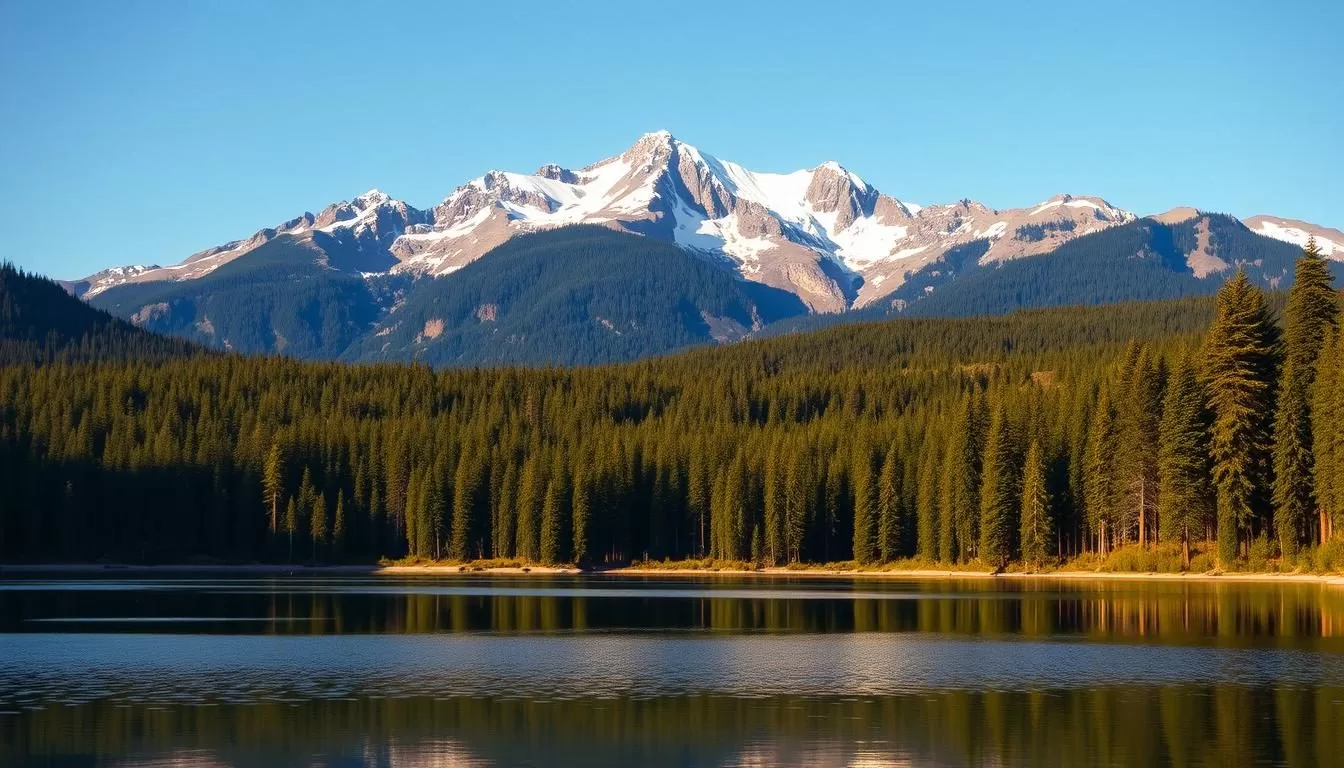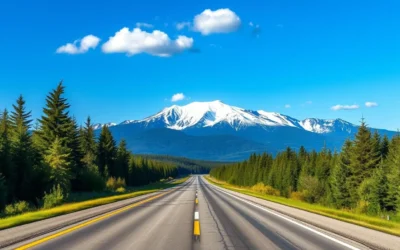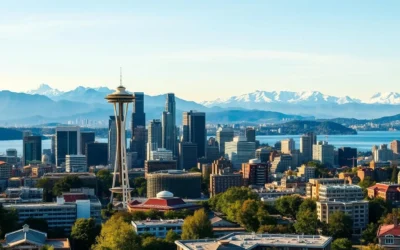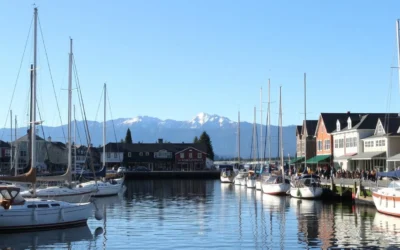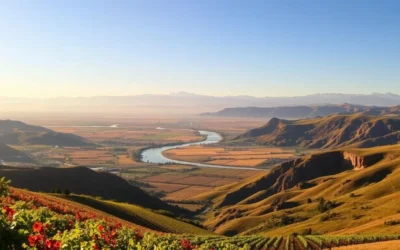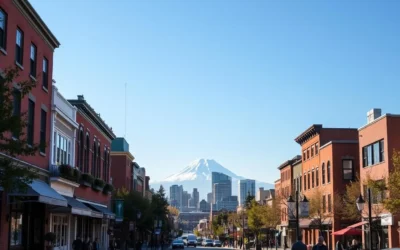✓ Accommodations ✓ Flights ✓ Rental Cars
Imagine a place where snow-capped peaks rise above meadows filled with wildflowers, and temperate rainforests hide waterfalls where salmon leap. Welcome to Olympic National Park, a vast wilderness area in Washington State that promises breathtaking diversity and unforgettable adventures.
This lesser-known gem is home to rugged coastlines, lush rainforests, and mountains, all within a single destination. As one of the most diverse national parks in the United States, it protects nearly a million acres of wilderness, offering a haven for nature lovers, hikers, and photographers alike.
As you plan your visit, get ready to explore distinct ecosystems, from hiking alpine trails to discovering the secrets of tide pools along the Pacific coast. With so much to see and do, the Olympic Peninsula is a destination that deserves more than just a quick visit.
Discovering the Olympic Peninsula: A Natural Wonder
As a natural wonder, the Olympic Peninsula offers a unique blend of landscapes and ecosystems. This diversity makes it an attractive destination for visitors from around the world.
Geography and Ecosystems of the Peninsula
The Olympic Peninsula is characterized by its vast array of ecosystems, including temperate rainforests, glacier-capped mountains, and over 70 miles of coastline. The varied geography supports a wide range of flora and fauna, making it a haven for wildlife enthusiasts. The Olympic National Park, a UNESCO World Heritage Site, is a significant part of this peninsula, protecting its natural beauty for future generations.
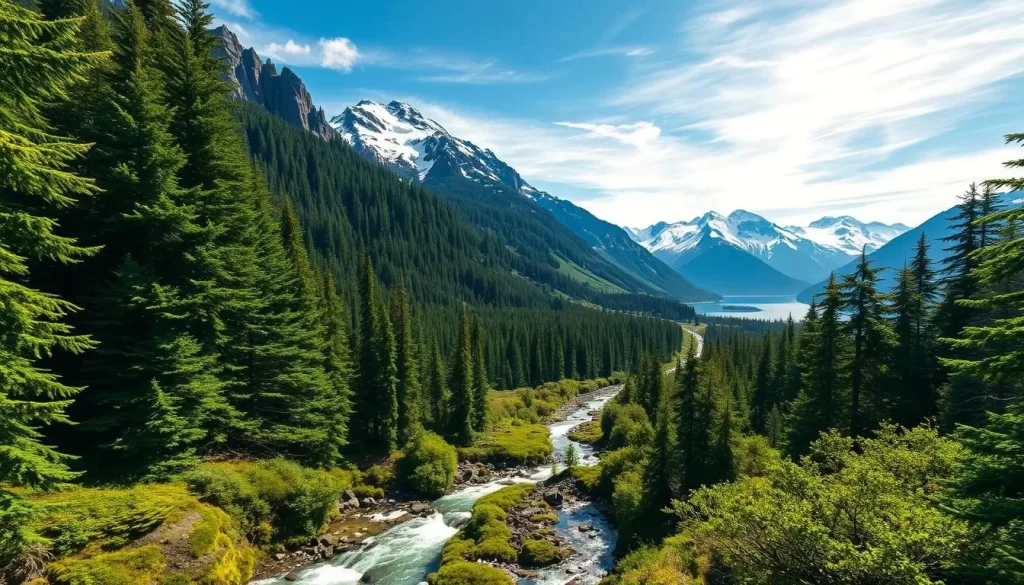
Best Time to Visit Olympic Peninsula
The best time to visit the Olympic Peninsula depends on your preferences. Summer is the peak tourist season, with warm weather and all roads open, but it’s also the busiest time. If you’re looking for fewer crowds, consider visiting in the spring or autumn. Spring, particularly May and June, is ideal for seeing wildflowers bloom and waterfalls at their peak. Autumn brings the elk mating season in September, making it a great time for wildlife viewing.
| Season | Characteristics | Activities |
|---|---|---|
| Spring | Temperatures warming up, wet season ending | Wildlife viewing, wildflowers blooming |
| Summer | Warm weather, all roads open | Hiking, camping, tidepooling |
| Autumn | Elk mating season, foliage | Wildlife viewing, photography |
| Winter | Cold, snow, and rain | Cross-country skiing, snowshoeing |
Understanding the months and seasons can help you plan your trip to Olympic National Park and the surrounding national parks, ensuring a memorable experience.
Planning Your Olympic Peninsula Adventure
Before you embark on your journey to the Olympic Peninsula, it’s crucial to plan ahead. This ensures that your trip is both enjoyable and stress-free.
How to Get There and Getting Around
The Olympic Peninsula is accessible by car via several highways, including US-101. If you’re flying, the nearest major airport is Seattle-Tacoma International Airport, from where you can rent a car or take a shuttle service to the peninsula. Once there, having a vehicle is essential for getting around, as public transportation is limited.
Renting a car or bringing your own vehicle allows you to explore the area at your own pace, including visiting remote areas like the coastline and wilderness trails.
Recommended Itineraries
With so much to see and do, planning your itinerary is key. Consider allocating your time based on the areas you wish to explore, such as Hurricane Ridge, the Hoh Rainforest, or the coastal beaches. A typical visit can range from a few days to a week.
| Area | Activities | Recommended Time |
|---|---|---|
| Hurricane Ridge | Hiking, Wildlife Viewing | 1-2 Days |
| Hoh Rainforest | Hiking, Exploring | 1 Day |
| Coastal Beaches | Beachcombing, Tidepooling | 1 Day |
Park Fees and Permits
Visiting Olympic National Park requires an entrance fee. You can buy a $30 7-day pass at a park entrance station, or use your America the Beautiful or other interagency annual pass. Some activities, like wilderness camping or visiting certain tribal lands, require additional permits.
Understanding the fee structure helps you budget for your visit. For example, a 7-day vehicle pass covers all passengers, making it economical for families or groups. The America the Beautiful Annual Pass ($80) is a good option if you plan to visit multiple national parks within a year.
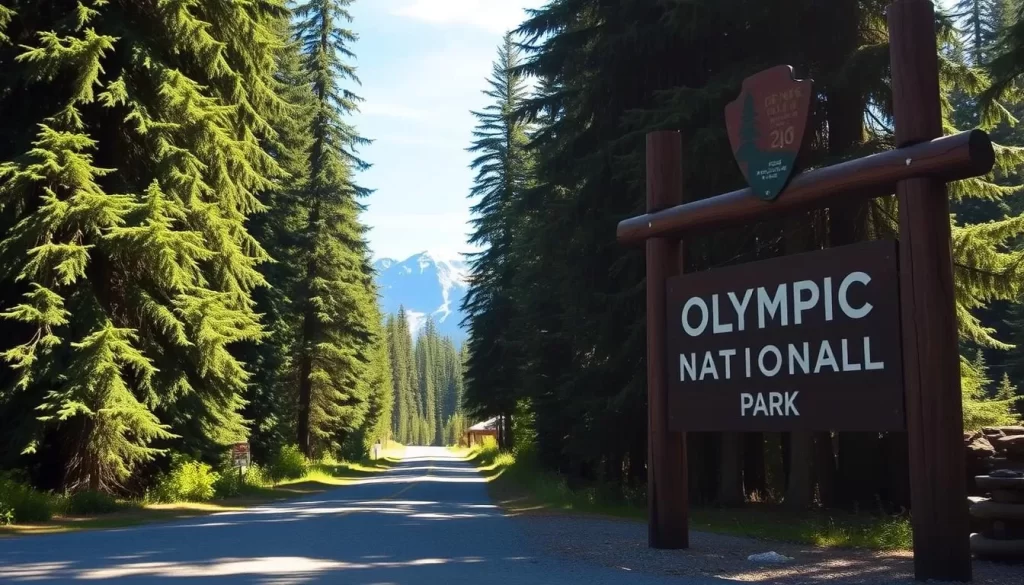
Exploring Hurricane Ridge: Alpine Majesty
Discover the breathtaking beauty of Hurricane Ridge, a crown jewel of Olympic National Park. As you explore this alpine destination, you’ll be treated to stunning vistas and diverse landscapes that make it a must-visit for any nature enthusiast.
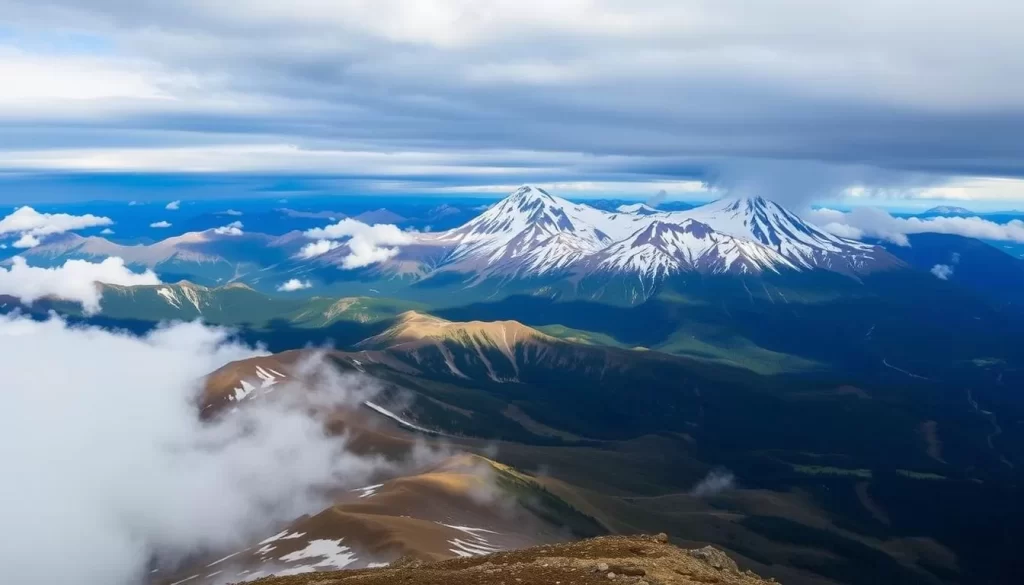
Hurricane Ridge Visitor Center and Viewpoints
The Hurricane Ridge Visitor Center is your gateway to understanding the unique ecosystems and geological features of the area. Here, you can gather information, view exhibits, and get insights from park rangers about the best viewpoints and trails to explore. The viewpoints surrounding the visitor center offer breathtaking 360° views of the Olympic Mountains, Puget Sound, and on clear days, even Mount Rainier.
Take a moment to appreciate the scenery from the various viewpoints, each offering a unique perspective on the alpine landscape. The accessibility of these viewpoints makes Hurricane Ridge an ideal destination for visitors of all ages and abilities.
Best Hiking Trails at Hurricane Ridge
Hurricane Ridge is renowned for its diverse hiking trails, catering to all skill levels from easy nature walks to more challenging mountain ascents. You can choose from a variety of trails, each offering unique experiences and breathtaking views.
- Explore the popular Hurricane Hill Trail, a 3.2-mile round trip hike that offers spectacular panoramic views with moderate effort.
- For a family-friendly experience, consider the Cirque Rim and Big Meadow trails, which showcase vibrant alpine wildflowers during the summer.
- More experienced hikers may enjoy the Klahhane Ridge Trail, known for its dramatic mountain views.
- The Obstruction Point Trail is another highlight, often cited as one of the most scenic trails in Olympic National Park, featuring high alpine terrain with views of glaciers and mountain lakes.
Remember to check trail conditions before you head out, as snow coverage can persist into July at higher elevations. Being prepared with the right gear, such as snowshoes, can make your hiking experience more enjoyable.
Lake Crescent: Crystal Clear Waters and Forest Trails
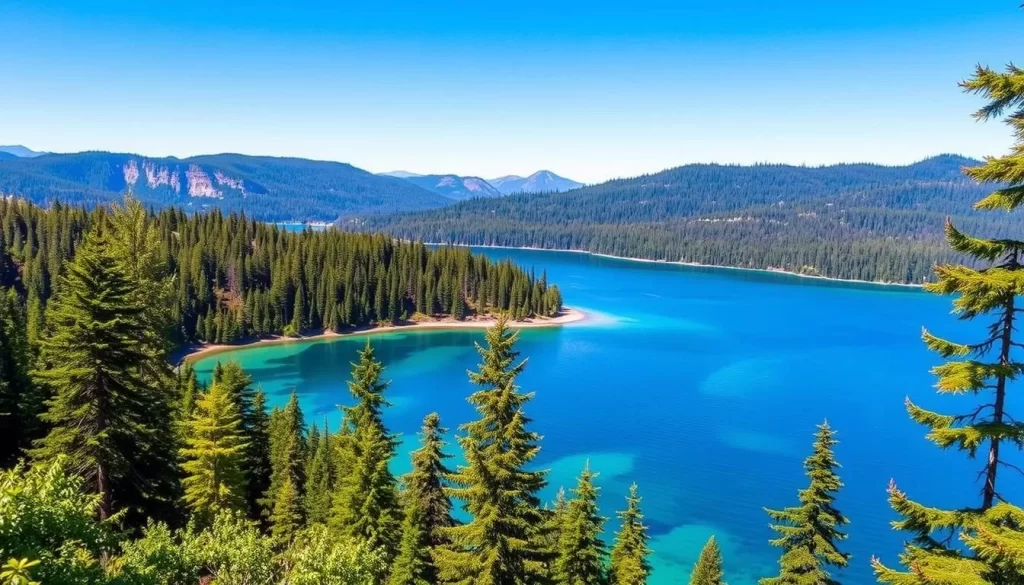
Lake Crescent is a serene destination within Olympic National Park, offering crystal-clear waters and picturesque forest trails. You can enjoy a variety of activities here, from water sports to hiking through the beautiful landscapes.
Water Activities on Lake Crescent
You can explore Lake Crescent’s crystal-clear waters through various water activities. Kayaking or canoeing are great ways to experience the lake’s tranquility and enjoy the surrounding scenery. The lake’s clarity offers a unique opportunity to observe fish and other aquatic life.
Marymere Falls Trail
The Marymere Falls Trail is a short, 1.8-mile round-trip hike that leads you to a stunning 90-foot waterfall. This trail is suitable for families and is a great introduction to the natural beauty of Olympic National Park.
Mount Storm King Hike
For a more challenging adventure, consider the Mount Storm King hike. This 5.3-mile round-trip trail is rated as difficult due to its steep elevation gain and some exposed sections. However, the panoramic views from the summit, including Lake Crescent and the surrounding mountains of Olympic National Park, make it a rewarding experience.
When planning your visit to Lake Crescent, keep in mind the best times to enjoy these activities and always check the current conditions to ensure a safe and enjoyable experience.
Olympic Peninsula, Washington: Best Things to Do in the Temperate Rainforests
Immerse yourself in the lush beauty of the Olympic Peninsula’s temperate rainforests, a world-renowned destination within Olympic National Park. The rainforests here are not only a marvel of nature but also a haven for biodiversity, featuring some of the most significant rainforests in the United States.
Hoh Rainforest and Hall of Mosses Trail
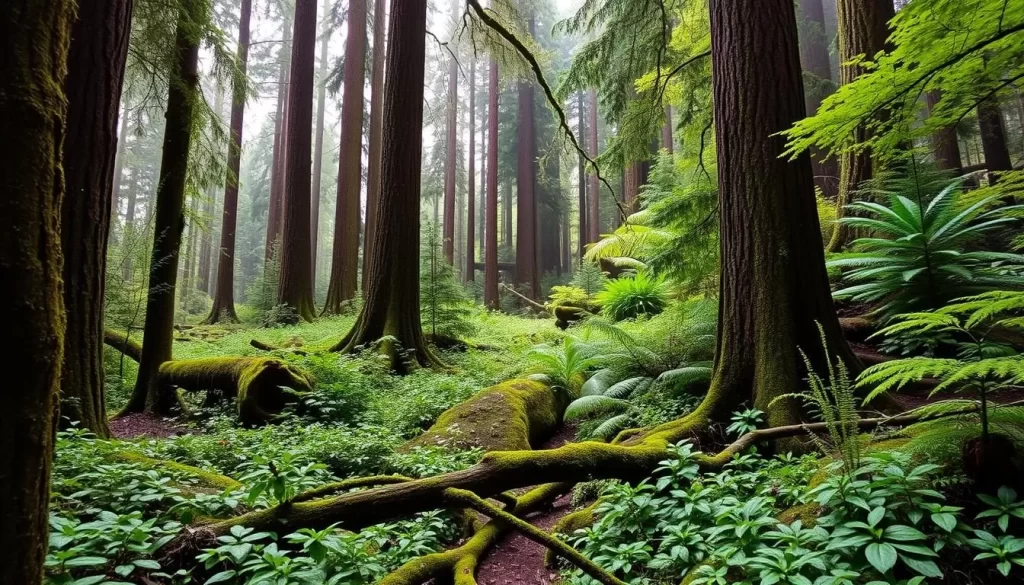
The Hoh Rainforest is one of the largest temperate rainforests in the United States, located within Olympic National Park. It boasts an incredible array of flora and fauna, with the Hall of Mosses Trail being a highlight. This trail takes you through a surreal landscape dominated by massive spruce and fir trees draped in moss.
The Hall of Mosses Trail is a short, 0.8-mile loop that’s perfect for a quick exploration of the rainforest’s enchanting environment. For those looking for more adventure, the Hoh River Trail offers longer hiking options, ranging from day hikes to multi-day backpacking trips.
Quinault Rainforest and Valley

The Quinault Rainforest, located in the southwestern part of Olympic National Park, is another gem waiting to be explored. The valley surrounding Lake Quinault is home to some of the largest trees in the world, including the world’s largest Sitka Spruce. Visitors can enjoy short, family-friendly trails such as the Quinault Rainforest Nature Trail and the World’s Largest Spruce Trail.
For a more challenging adventure, the Enchanted Valley Trail is a 13-mile hike along the East Fork Quinault River, leading to the historic Enchanted Valley Chalet. This multi-day backpacking trip offers the chance to spot wildlife like bears, elk, and deer, and to camp at designated sites along the way.
Exploring the Rugged Pacific Coastline
With its unique sea stacks, driftwood-strewn beaches, and pristine tide pools, the Olympic Peninsula’s Pacific coastline is a nature lover’s paradise.
The rugged shoreline is characterized by its dramatic landscapes and untouched natural beauty, making it a must-visit destination for anyone exploring the Olympic Peninsula.
Ruby Beach: Sea Stacks and Driftwood
Ruby Beach is one of the most striking beaches along the Olympic Peninsula’s coastline, known for its sea stacks and abundant driftwood.
As you walk along the beach, you’ll be captivated by the dramatic sea stacks rising out of the ocean and the unique driftwood sculptures shaped by the relentless tides.
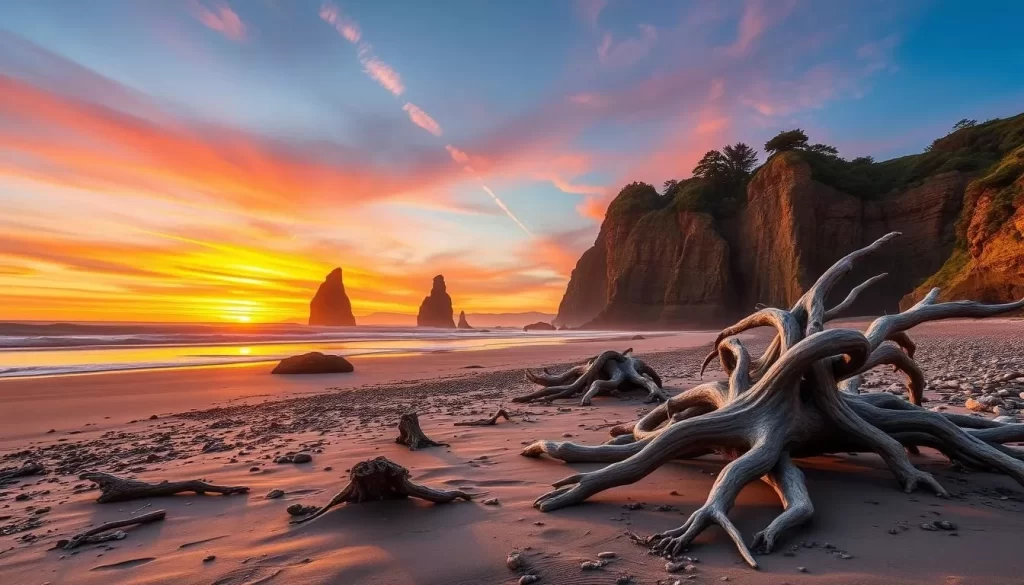
Rialto Beach and Hole-in-the-Wall
Rialto Beach is another gem along the Olympic Peninsula’s Pacific coastline, famous for its Hole-in-the-Wall rock formation.
As you explore the beach, you’ll discover the iconic Hole-in-the-Wall, a natural rock arch that has been carved out by the constant pounding of the waves.
The beach is also known for its tide pools, which are home to a variety of marine life, including colorful starfish and sea anemones.
Shi Shi Beach and Point of Arches
Shi Shi Beach, located within Olympic National Park, is renowned for its stunning natural beauty and unique geological formations.
To reach Shi Shi Beach, you’ll need to hike approximately 3 miles from the trailhead, which is located on the Makah Reservation, requiring both an Olympic National Park entrance fee and a Makah Recreation Pass.
Once you arrive, you’ll be rewarded with breathtaking views of the coastline, including the dramatic Point of Arches, where dozens of sea stacks and natural arches create one of the most photographed coastal landscapes in Washington.
The beach is also a great spot for tide pooling at low tide, where you can discover colorful marine creatures.
Must-See Waterfalls of Olympic Peninsula
From easily accessible cascades to more secluded falls, the Olympic Peninsula offers a diverse range of waterfall experiences. The Olympic National Park is renowned for its stunning natural beauty, and its waterfalls are a major highlight.
Sol Duc Falls
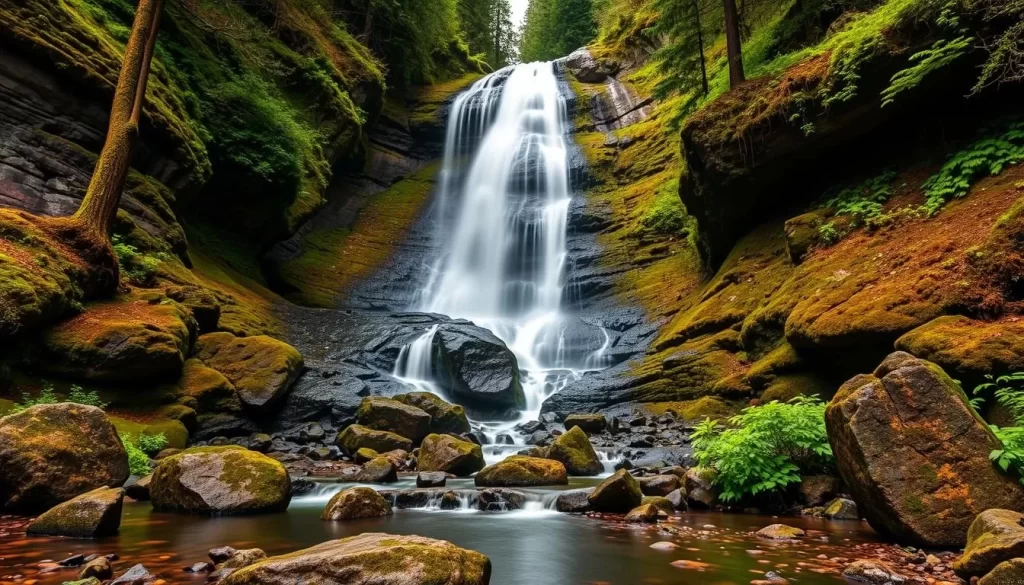
One of the most popular waterfalls in the Olympic National Park is Sol Duc Falls. The Sol Duc Falls hiking trail is a must-visit, offering a moderately difficult hike that rewards visitors with the sight of a beautiful 48-foot waterfall. The trail is surrounded by lush forest, making it a great spot for nature lovers and hiking enthusiasts.
Madison Falls and Other Hidden Cascades
For those looking for more accessible waterfalls, Madison Falls is an excellent choice. Located near the Elwha River, this 60-foot cascade is just a short 0.1-mile paved trail from the parking area, making it perfect for visitors with limited mobility. Other hidden cascades worth exploring include Beaver Falls, Rocky Brook Falls, and Murhut Falls. The Olympic National Park is also home to numerous other waterfalls, each with its unique charm and seasonal changes that affect their flow and surroundings.
The restoration of the Elwha River ecosystem following the removal of two dams has also impacted the waterfalls in the area, with spring offering the most dramatic flows and fall providing beautiful foliage as a backdrop. Visitors can enjoy hiking to these waterfalls and capturing their beauty through photography.
Unique Natural Wonders and Viewpoints
As you explore the Olympic Peninsula, you’ll discover unique natural wonders that will leave you in awe. The region is home to diverse landscapes, from rugged coastlines to ancient forests, each offering breathtaking views and unforgettable experiences.
Cape Flattery: The Northwesternmost Point
Cape Flattery is a must-visit destination on the Olympic Peninsula, marking the northwesternmost point of the contiguous United States. To experience this natural wonder, take the Cape Flattery trail, a moderately difficult hike that rewards you with stunning views of the Pacific Ocean and the surrounding coastline.
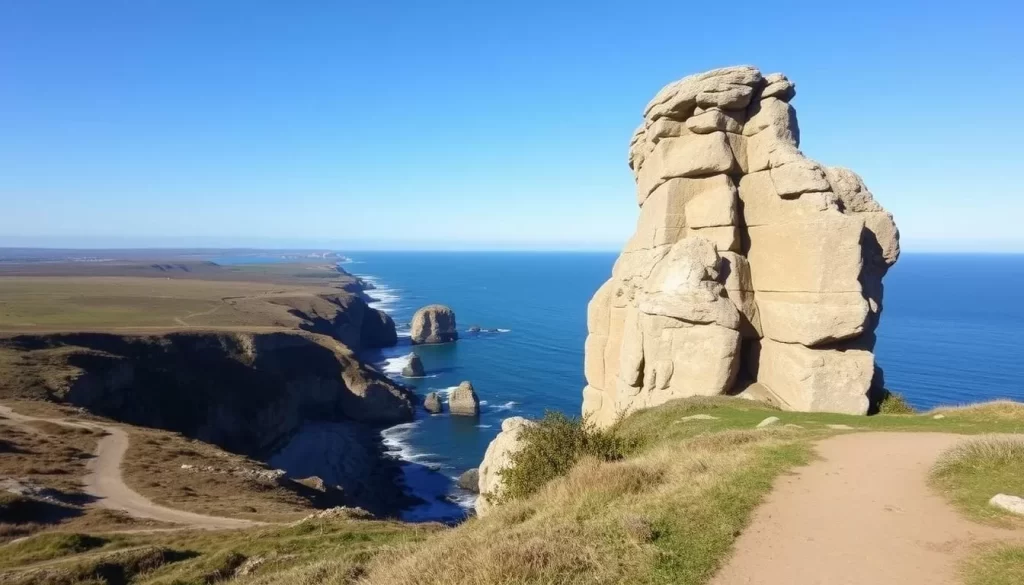
Kalaloch Tree of Life
The Kalaloch Tree of Life, also known as the “Root Tree,” is a remarkable 1000+-year-old Sitka Spruce that continues to thrive despite having most of its root system exposed by erosion. Located on the beach near the Kalaloch Campground, this natural wonder is accessible via a short walk down from the parking area.
- Marvel at the tree’s massive root system, which forms a cave-like opening large enough for visitors to walk through.
- Learn about the geological processes that created this unique phenomenon and the tree’s remarkable adaptation to its precarious position.
- Understand the cultural significance of this tree to local indigenous communities and its symbolism of resilience.
Visiting these unique natural wonders is a great way to experience the beauty and diversity of Olympic National Park. Remember to respect these fragile environments and leave them better than you found them.
Wildlife Viewing Opportunities
As you explore the Olympic Peninsula, you’ll discover an incredible array of wildlife, from majestic elk to playful river otters. The diverse landscapes of Olympic National Park support a wide range of ecosystems, making it an ideal location for observing animals in their natural habitats.
Marine Wildlife Along the Coast
The coastal waters of Olympic National Park are home to a variety of marine wildlife. You can spot sea otters floating on their backs, gray whales migrating along the coast, and a diverse array of seabirds, including puffins and gulls. The tidepools at places like Ruby Beach are teeming with life, featuring colorful sea anemones, starfish, and crabs.
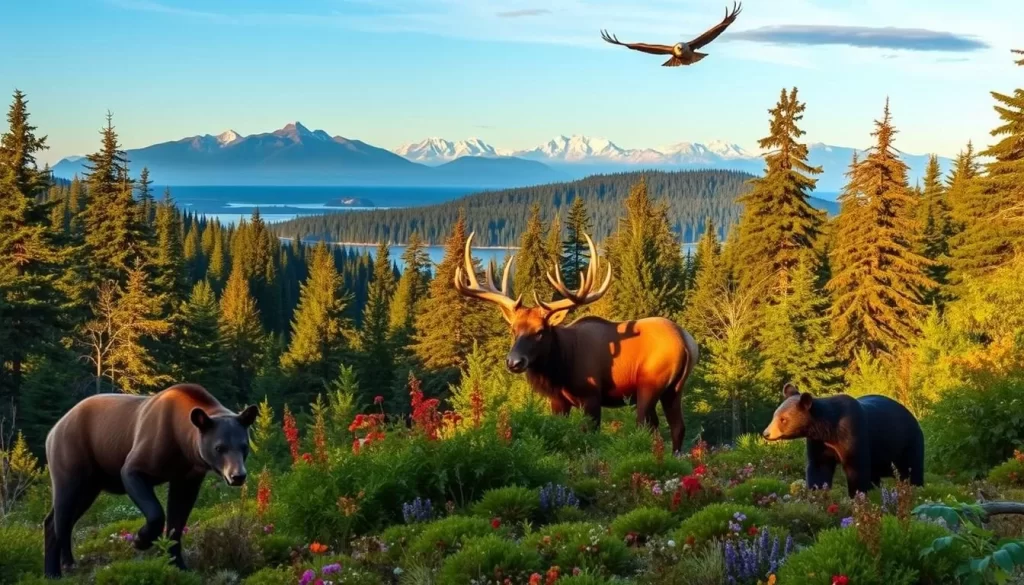
Forest and Mountain Wildlife
The forests and mountains of Olympic National Park are inhabited by an equally impressive array of wildlife. Keep an eye out for Roosevelt elk grazing in meadows, black bears roaming through the forests, and mountain goats scaling steep slopes. The park is also home to numerous bird species, including the endangered northern spotted owl. Spring and autumn are particularly good times for wildlife viewing, as many animals are more active during these seasons.
| Wildlife | Location | Best Time to Visit |
|---|---|---|
| Roosevelt Elk | Hoh and Quinault valleys | Spring and Autumn |
| Black Bears | Subalpine meadows | Summer |
| Mountain Goats | Mountain slopes | Year-round |
Cultural Experiences and Small Towns
As you explore the Olympic Peninsula, you’ll discover a blend of cultural experiences, history, and small-town charm. The region is home to a rich indigenous heritage, with eight tribes having centuries of history and cultural connection to the land.
Port Angeles: Gateway to Olympic
Port Angeles is a charming town that serves as the gateway to Olympic National Park. When visiting, you can find a range of accommodations to suit your needs. For the best options, search for Port Angeles Washington accommodations to book your stay.
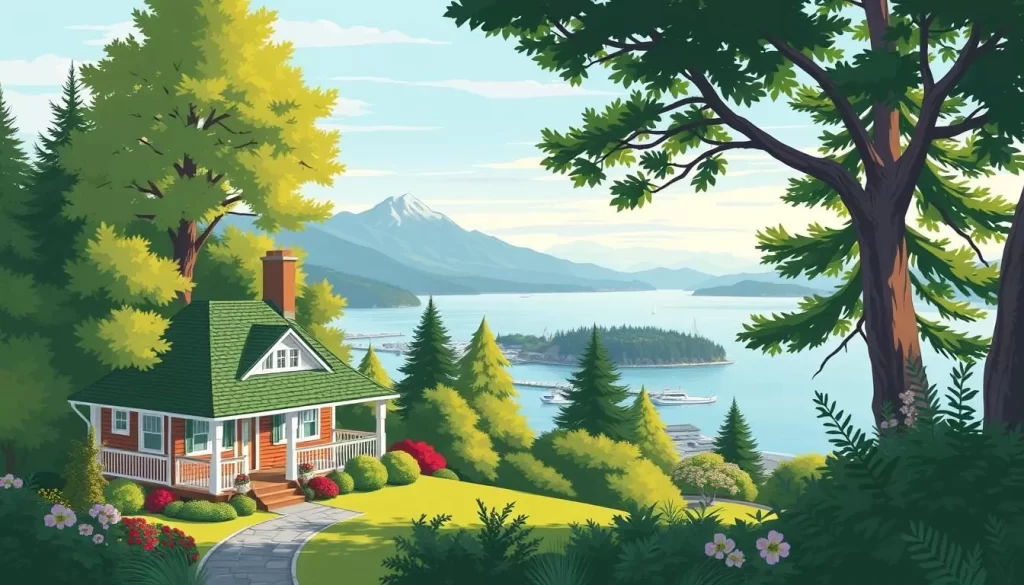
Forks and the Twilight Connection
Forks is another town on the Olympic Peninsula that has gained fame due to its connection with the Twilight Saga. While visiting Forks, you can explore the local culture and learn about its history. The town has a unique charm that attracts fans of the series and nature lovers alike.
Native American Heritage Sites
The Olympic Peninsula is home to a rich Native American heritage, with several sites to explore. You can visit the Makah Cultural and Research Center in Neah Bay to learn about traditional Makah life and see artifacts from the Ozette archaeological site. Additionally, the Quileute Oceanside Resort in La Push offers insights into Quileute cultural traditions. The Jamestown S’Klallam Tribal Center near Sequim features impressive totem poles and a tribal art gallery, showcasing the region’s cultural and history.
When visiting areas like Cape Flattery and La Push, it’s essential to respect tribal lands and obtain the necessary permits. The ongoing relationship between the National Park Service and the peninsula’s indigenous communities is crucial in managing these ancestral lands.
Where to Stay: Lodging Options
Finding the perfect lodging is an essential part of planning your Olympic National Park adventure. The right accommodation can enhance your experience, providing comfort and convenience as you explore the park’s diverse landscapes.
Historic Park Lodges
The Olympic National Park is home to several historic lodges that offer a unique and memorable stay. These lodges are part of the park’s charm, providing a rustic yet comfortable experience. The Sol Duc Hot Springs Resort and the Kalaloch Lodge are popular choices, offering stunning views and easy access to park attractions.
Camping and RV Sites
For those who prefer a more adventurous experience, the national park offers numerous camping and RV sites. These range from primitive sites to those with full amenities, catering to different preferences and needs. Camping in the park allows you to immerse yourself in nature, with many sites located near hiking trails and scenic viewpoints.
Towns and Cities with Accommodations
The areas surrounding Olympic National Park, such as Port Angeles and Forks, offer a variety of accommodations to suit different budgets and preferences. Port Angeles is a convenient base for exploring the park’s northern areas, while Forks is ideal for visiting the western parts of the park. Other towns like Sequim and Aberdeen also provide lodging options, ranging from budget-friendly motels to luxury vacation rentals.
When planning your trip to this part of Washington, consider staying in these towns to experience the local culture and hospitality.
Seasonal Activities and Events
As the seasons change, Olympic National Park transforms into a diverse playground for outdoor enthusiasts. The park’s varied landscapes and climates offer a wide range of activities and events throughout the year.
Summer Recreation
During the summer months, the park is bustling with activities. You can enjoy hiking, camping, and wildlife viewing in the park’s temperate rainforests and alpine regions. The higher elevation areas like Hurricane Ridge offer stunning views and exciting outdoor adventures.
Some popular summer activities include exploring the coastline, visiting the park’s many beaches, and taking part in ranger-led programs.
Fall Foliage and Winter Activities
As autumn arrives, the park’s foliage transforms into a kaleidoscope of colors, making it a great time for leaf-peeping. The Elwha Valley, Lake Crescent, and Quinault Valley are particularly known for their vibrant fall colors, peaking in mid-October. In the winter, the park takes on a serene quality, with Olympic National Park offering a range of activities like snowshoeing, cross-country skiing, and storm watching.
Hurricane Ridge is a popular destination for winter sports, with significant snowfall creating ideal conditions for skiing and snowshoeing. You can also explore the park’s rainforests, which take on a mystical quality during the winter months.
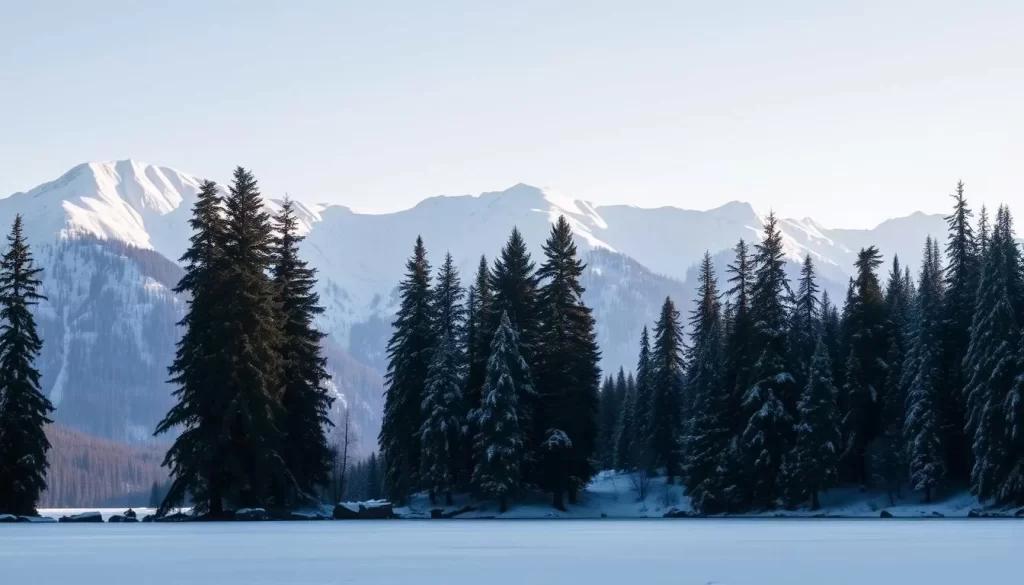
Conclusion
From the rugged Pacific coastline to the majestic alpine meadows, the Olympic Peninsula is a treasure trove of natural wonders. As you explore this incredible destination, you’ll discover a diverse range of landscapes that are unlike anywhere else in the United States. The Olympic National Park, a UNESCO World Heritage Site, is a highlight of the peninsula, offering a unique blend of adventure and tranquility.
Whether you’re hiking through the moss-draped Hoh Rainforest, exploring the wild Pacific beaches, or taking in the breathtaking views from Hurricane Ridge, your trip to the Olympic Peninsula will be an unforgettable experience. With its rich cultural heritage and stunning natural beauty, this remote corner of Washington is a must-visit destination for any nature lover or adventure seeker.
As you plan your trip to the Olympic Peninsula, consider the many parks and protected areas that offer a range of recreational activities and opportunities to connect with nature. With its unique blend of landscapes and experiences, the Olympic National Park and the surrounding Olympic Peninsula are sure to leave you with lifelong memories of your adventures.
The above is subject to change.
Check back often to TRAVEL.COM for the latest travel tips and deals.
